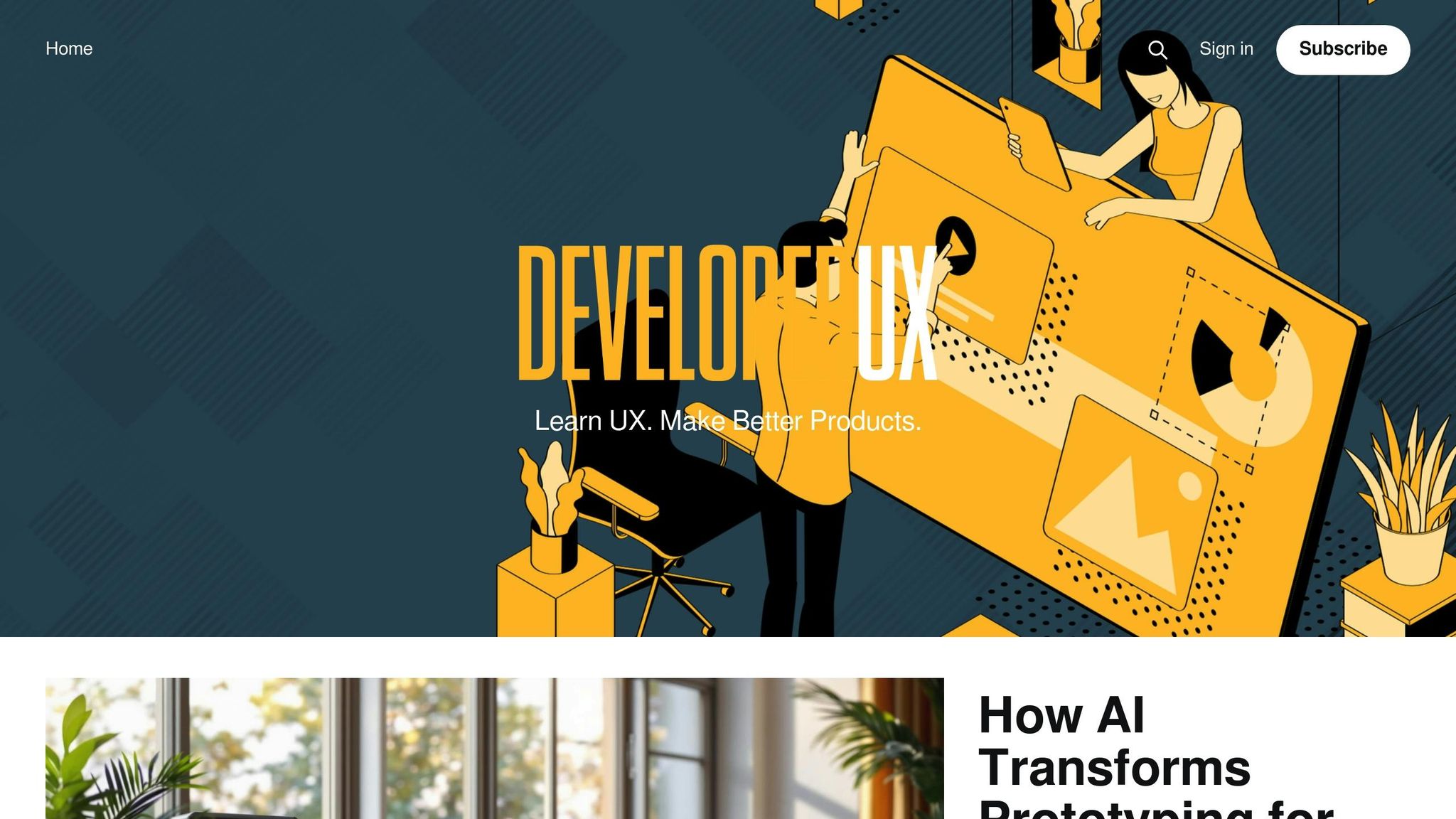5 Tips for Managing Client Expectations in UX
Learn how to effectively manage client expectations in UX through clear communication, structured processes, and strategic feedback management.

Managing client expectations in UX is about balancing client goals, user needs, and project limitations. Misaligned expectations can lead to delays, increased costs, and strained relationships. Here’s how you can avoid that:
- Understand Client Needs: Start with detailed discovery sessions to define goals, timelines, and constraints. Document everything clearly.
- Set Clear Goals: Use SMART goals (Specific, Measurable, Achievable, Relevant, Time-bound) to align expectations and track progress.
- Communicate Effectively: Choose the right tools, maintain regular updates, and set clear feedback processes.
- Control Scope: Define project boundaries early and manage change requests systematically.
- Use Feedback Wisely: Collect and prioritize client input while keeping the project on track.
Managing Design Expectations - Practical UX Weekly
Learn What Clients Want
Understanding what clients need is a key part of UX work. Setting clear, written requirements from the start helps avoid scope creep and keeps the project on track.
Run Initial Client Meetings
Kick off the project with structured client meetings. Use discovery workshops with key stakeholders to clarify:
- Business goals: Define success metrics and key performance indicators (KPIs).
- User personas: Identify who the target users are and what they need most.
- Technical limitations: Understand platform constraints and integration needs.
- Timeline expectations: Outline major milestones and delivery dates.
- Budget boundaries: Confirm financial limits for the project.
Pay attention to what’s said - and what’s not said. For example, if a client asks for "a modern design", ask follow-up questions like:
- What does "modern" mean for your brand?
- Are there competitor designs you like?
- What emotions or reactions do you want users to have when interacting with your product?
Record these details to shape the project’s direction.
Document Requirements Up Front
Turn your client discussions into a detailed requirements document. This serves as the foundation for the project. Include key sections like:
Project Scope Statement
- Deliverables
- Project boundaries
- Success criteria
- Assumptions and constraints
Acceptance Criteria
- Maximum clicks for completing key tasks
- Load time goals
- Compatibility across devices and browsers
Change Management Process
- Who can request changes
- How changes affect the timeline and budget
- Steps for approval
- Documentation methods
Get written approval before starting the design phase. Use a version-controlled system to track and manage any changes that come up. This keeps everyone aligned and avoids misunderstandings.
Create Clear Project Goals
Setting clear project goals helps align client expectations, avoid misunderstandings, and focus on measurable results.
Use SMART Goals
Turn client requirements into SMART goals - Specific, Measurable, Achievable, Relevant, and Time-bound - to ensure clarity and track progress effectively.
Break the project into clear deliverables:
Specific
- Define exact features and functionalities.
- Detail specific user interactions.
- Set clear performance metrics.
Measurable
- Track user engagement rates.
- Monitor task completion stats.
- Establish quantifiable success benchmarks.
Achievable
- Assess team capacity and skill sets.
- Account for technical limitations.
- Plan based on available resources.
Relevant
- Align goals with business objectives.
- Prioritize user needs.
- Ensure goals support the overall project vision.
Time-bound
- Set realistic deadlines.
- Include time for revisions.
- Plan milestone reviews.
If requests don’t meet these criteria, consider alternative approaches.
Manage Unrealistic Requests
Handle overly ambitious requests by offering practical, data-backed solutions:
1. Understand the Core Need
Pinpoint the real need behind the request. Even unrealistic demands often stem from genuine business concerns.
2. Provide Data-Driven Alternatives
Break down complex requests into realistic timelines. For example, if a client wants a complex feature completed in a week, present a standard timeline like this:
| Task | Time Needed | Why It’s Needed |
|---|---|---|
| Design | 3-5 days | User research and wireframing |
| Development | 7-10 days | Coding and testing |
| QA | 2-3 days | Bug fixes and optimization |
| Review | 2-3 days | Client feedback integration |
3. Suggest a Phased Approach
Divide the project into manageable phases to keep progress on track while addressing scope concerns:
- Phase 1: Core functionality.
- Phase 2: Additional features.
- Phase 3: Advanced capabilities.
This approach ensures progress while managing expectations effectively.
Keep Communication Clear
Clear communication is the backbone of successful client relationships. It helps avoid misunderstandings and ensures projects stay on track.
Pick Communication Tools
Choose tools that match the project's needs and create a system that works for everyone.
Primary Tools
- Project management platforms: Ideal for task tracking and documentation.
- Video calls: Best for detailed discussions.
- Email: Useful for formal approvals and decisions.
Supporting Tools
- Software for design collaboration.
- Instant messaging for quick exchanges.
- Screen recording tools for visual explanations.
| Communication Type | Primary Tool | Response Time |
|---|---|---|
| Project Updates | PM Platform | 24 hours |
| Design Reviews | Video Call | Scheduled |
| Quick Questions | Chat | 4 hours |
| Formal Decisions | 48 hours |
Once tools are set, establish a regular update schedule to keep everyone on the same page.
Set Update Schedule
Share weekly updates to cover milestones and upcoming tasks. Include monthly reviews to discuss timelines, budgets, and risks.
Stick to a consistent format so clients can quickly understand the project's status:
- Achievements: Completed tasks.
- In Progress: Current work.
- Blockers: Issues that need attention.
- Next Steps: Priorities moving forward.
Give Better Feedback
Feedback sessions should be clear and constructive, building on structured communication and regular updates.
Focus on Solutions
- Instead of saying, "The timeline isn't feasible", try, "We can adjust the scope to meet your deadline."
- Replace "That won't work" with "Here's an alternative approach to achieve your goal."
Back Decisions with Data
- Reference results from user testing.
- Share benchmarks from the industry.
- Use analytics from similar projects to support recommendations.
Feedback Framework
- Context: Explain the situation with relevant facts.
- Impact: Describe how it affects project goals or timelines.
- Options: Offer alternative solutions with trade-offs.
- Recommendation: Provide a clear path forward and explain why it works.
Control Project Scope
Keeping project boundaries well-defined helps avoid scope creep and ensures projects are delivered on time and within budget.
Write Clear Requirements
Initial documentation provides a foundation, but detailed requirements are crucial for defining the exact scope.
Key Elements of Requirements Documentation
- Project Phases: Clearly outline start and end points for each stage.
- Deliverables: Specify outputs along with acceptance criteria.
- Timeline: Include major milestones and any dependencies.
- Resource Allocation: Define team roles and time commitments.
- Success Metrics: Set measurable outcomes to track progress.
This structure clarifies the scope from the start and helps manage any changes effectively.
| Requirement Type | What to Include | Example |
|---|---|---|
| Feature Specs | Functionality details, user flows | "User can filter products by 3 criteria: price, category, rating" |
| Visual Design | Style guidelines, component specs | "All buttons follow brand style guide v2.0 with 8px padding" |
| Technical | Platform requirements, performance metrics | "Page load time under 2 seconds on 4G connections" |
Handle Extra Requests
Once the scope is defined, additional requests can be managed systematically.
Assess the Impact
Before approving changes, evaluate how they affect:
- Timeline
- Budget
- Resource availability
- Technical feasibility
- User experience goals
Steps to Address Changes
1. Document the Request: Capture the details, including business justification, technical requirements, and potential impact.
2. Analyze Trade-offs: Show options such as:
- Time vs. feature adjustments
- Cost implications
- Quality considerations
3. Propose Solutions: Offer alternatives that keep the scope intact:
- Defer changes to a later phase
- Simplify the requested feature
- Adjust other features to make room
Change Request Process
| Stage | Action | Timeline |
|---|---|---|
| Initial Review | Assess feasibility | 1-2 days |
| Impact Analysis | Calculate effort/cost | 2-3 days |
| Client Discussion | Present options | 7 days |
| Documentation | Update project scope | 1-2 days |
Use Client Input Well
Client feedback plays a key role in successful UX projects, but managing it effectively requires a structured approach.
Get Regular Feedback
Plan feedback sessions around major project milestones to keep things organized and on track.
Feedback Collection Framework
| Project Phase | Focus Areas |
|---|---|
| Discovery | User personas, project goals |
| Design | Wireframes, visual design |
| Development | Feature implementation |
| Testing | Performance, usability |
Tips for Feedback Sessions
- Share materials at least 48 hours before the meeting.
- Focus discussions on 3-5 key decisions to avoid overwhelming participants.
- Define clear acceptance criteria for each review to streamline decision-making.
Once you’ve established a regular feedback process, the next step is to manage and prioritize the input effectively.
Stay on Track with Changes
After collecting feedback, it’s important to filter and implement changes without disrupting the project timeline. Just like documenting requirements, tracking feedback ensures the project stays aligned with its goals.
Feedback Evaluation Process
- Assess Impact
Analyze how suggested changes affect the timeline, team capacity, UX goals, and budget.
- Prioritize Changes
Use a simple priority matrix to decide what to tackle first:
| Priority Level | Implementation Criteria | Response Time |
|---|---|---|
| Critical | Impacts core functionality | Within 24 hours |
| High | Affects user experience | Within 3 days |
| Medium | Enhances features | Next sprint |
| Low | Non-essential improvements | Backlog |
- Track Implementation
Keep detailed records of feedback and its status, including:
- Original request details
- Current implementation status
- Resource allocation
- Estimated completion timeline
- Impact on deliverables
Managing Change Requests
- Document all approved changes clearly.
- Set a firm cutoff date for accepting change requests.
- Use visual tools to track progress and maintain transparency.
Leverage a feedback management tool to ensure version control and monitor design changes efficiently.
Wrapping It Up
Managing UX client expectations boils down to having clear documentation, structured communication, and a solid plan in place. Combine this with regular updates and consistent communication channels, and you’ve got a strong foundation for smooth project execution.
The essentials? Clear documentation, organized communication, thoughtful feedback management, and keeping the project scope in check. Together, these elements help ensure projects stay on track while addressing client needs effectively.
The real challenge is striking the right balance between meeting client demands and sticking to project goals. By setting up clear processes for handling feedback and changes, you can navigate this balance and keep both clients and users happy.
Want to dive deeper into UX client management? Check out DeveloperUX's Master Course on UX.
DeveloperUX Resources

Improve your client management skills with DeveloperUX's Master Course on UX. This course includes modules that tackle real-world client-facing challenges, offering practical insights to address them effectively.
The Type module focuses on presenting design decisions in a clear and impactful way. It highlights how typography influences user experience and equips you to explain these decisions to stakeholders with confidence. This ensures your team understands the reasoning behind your design choices.
The course also dives into incorporating AI into UX workflows, offering strategies to explain technical concepts in simple terms to non-technical stakeholders. This helps maintain alignment and clarity throughout the project.
Through practical exercises based on real-world scenarios - like designing internal tools - you'll build critical skills for managing complex client relationships and delivering successful UX projects.
Explore these resources at DeveloperUX to elevate your approach to client management.

